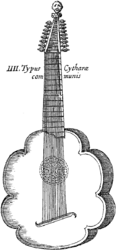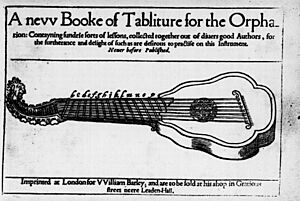Orpharion facts for kids

An orpharion, labeled cythara communis, from Kircher's Musurgia Universalis
|
|
| Classification | String instrument (plucked) |
|---|---|
| Hornbostel–Sachs classification | 321.322 (Composite chordophone) |
| Developed | 15th century |
| Related instruments | |
The orpharion is an old musical instrument from the Renaissance period. It is a type of string instrument that you play by plucking its strings with your fingers. The orpharion is part of the cittern family and is similar to the larger bandora. It is also an ancestor of the modern guitar.
Contents
What is an Orpharion?
The orpharion has metal strings, which are tuned in a similar way to a lute. You pluck these strings with your fingers to make music.
How it's Built
The parts that hold the strings at each end, called the nut and bridge, are usually slanted. This means the strings are longer on the low-sounding (bass) side and shorter on the high-sounding (treble) side.
The metal strings on an orpharion are not pulled very tight. Because of this, the frets (thin strips on the neck of the instrument) were almost flat with the fingerboard. The fingerboard itself was gently curved. This design helped the instrument play correctly without the strings bending too much when pressed down.
A Special Sound
Since the orpharion used metal strings, players had to be very gentle when plucking them. This was different from how people played the lute, which often used a stronger, sharper pluck.
History of the Orpharion
The orpharion was invented in England during the second half of the 1500s. In English music books from that time, it was often suggested as another instrument you could use instead of the lute.
Who Invented It?
According to a historical record called "Annals" from 1631, a person named John Rose invented the orpharion in 1581. He lived in a place called Bridewell.
One orpharion made by John Rose is kept at Helmingham Hall. People say it was given as a gift to Queen Elizabeth I. This might even be the very first orpharion ever made! It has six sets of strings (called courses), and its bridge and nut are straight across.
Surviving Orpharions
Besides the one at Helmingham Hall, there is only one other orpharion that still exists today. It is in the Claudius Collection in Copenhagen and was made in 1617. This instrument has nine courses of strings and its frets are fanned out.
Where Did the Name Come From?
The name orpharion is a mix of two names from ancient Greek stories: Orpheus and Arion. Orpheus was a famous musician, and Arion was a poet and singer.
Music for the Orpharion
In 1596, a man named William Barley published a book of music specifically for the orpharion. This book was called A new book of tablature for the orpharion. It contained different kinds of songs and pieces by well-known composers of the time, such as Francis Cutting, John Dowland, Philip Rosseter, Peter Philips, Anthony Holborne, Edward Johnson, and William Byrd. The book was made to help and entertain people who wanted to play this instrument.


